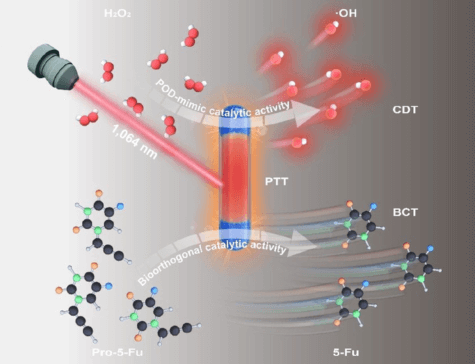BEIJING, China — A single five-minute treatment has the ability to destroy cancerous tumors without invasive surgery or noticeable side-effects, a new study reveals. Researchers at Tsinghua University say the promising procedure uses a laser to heat nanomaterials injected into the tumor — heating the cells and killing them.
In experiments on mice, one five-minute dose of near-infrared light successfully eliminated solid liver tumors without creating side-effects over the next month post-treatment.
“Tumor eradication has been the dream of cancer patients and researchers for many years,” says study author Ya Ding, professor at Key Laboratory of Drug Quality Control and Pharmacovigilance at China Pharmaceutical University, in a media release.
“It is of great importance to eliminate recurrence and metastasis of cancer elsewhere in the body. However, due to the complexity, diversity and heterogeneity of tumors, a single therapy is unlikely to completely eradicate the tumor. That’s why we aimed to design a simple material or system to synergistically treat and eradicate tumors.”
What is photothermal therapy?
Normal cancer treatments, including chemotherapy, often lead to painful side-effects for patients and may even damage healthy cells as doctors try to remove the entire tumor. Less invasive and less toxic options are available, but scientists don’t know if they’re aggressive enough to actually defeat cancer.
One of these treatments is photothermal therapy. Doctors inject nanomaterials, usually gold nanorods, into a cancerous tumor and then expose them to near-infrared light. The procedure excites the gold, causing the metal to give off heat which kills cancer cells. The new study looked at a three-pronged approach to make this therapy more effective at destroying tumors.
“Photothermal therapy is an attractive therapy for cancer because it is non-invasive, it provides high temporal-spatial resolution in precisely targeting tumors, and it is non-toxic,” explains study author Yanglong Hou, the Chang Jang Chair Professor of materials science and engineering at Peking University.
“Despite these promising advantages, photothermal therapy alone often results in failure, especially for larger tumors. We designed our treatment to build on the potential of this therapy with the hope of solving this problem.”

(CREDIT: Nano Research)
Supercharging nanomaterials to fight cancer
Scientists note that a higher frequency of light could penetrate deeper into a patient’s tissue, but this would also mean that doctors need to use gold nanorods with “a higher aspect ratio.” This means the procedure would be more invasive and actually become less effective overall.
To avoid this, study authors took the existing nanorods and enhanced them by adding palladium metal clusters to each end of the gold rods. This first step helps the laser excite gold nanorods at longer wavelengths, allowing the treatment to reach deeper cancer cells.
In the second stage, the nanomaterial also activates a chemotherapy drug (5-flurouracil) injected into the tumor cells.
The third prong of attack sees the nanomaterial mimic enzymes which convert hydrogen peroxide into reactive oxygen species. These free radicals force the cancer cells to “self-destruct.”
“For the first time, we made slight and reasonable structural changes to the nanorods, comprehensively improving the nanomaterials’ ability to navigate complex disease,” Ding says. “The result is a novel therapeutic agent that can effectively treat tumors.”
The team is now planning to examine how the nanoplatform impacts healthy cells and how the procedure may impact a patient’s metabolism following the treatment.
“There are several issues that attracted our attention during this project that we plan to further study with the goal of developing simple and cheap nanomaterials with high photothermal and catalytic activities to apply clinically,” Hou concludes. “While there is more work to do, this research provides a solution to current bottleneck problems of photothermal therapy to completely eliminate tumors in animal models without toxic side effects.”
They study is published in the journal Nano Research.
